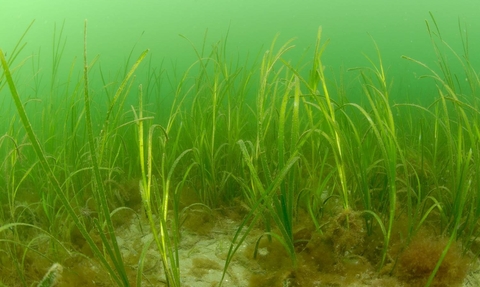
Seagrass bed © Paul Naylor
Blue carbon solutions to the climate crisis
Blue carbon habitats are incredibly important in the fight against climate change.
As well as being really important for biodiversity and wildlife, these coastal and marine habitats are good at removing carbon from the atmosphere and storing it over long time periods.
However, if they're damaged or destroyed they release carbon back into the sea and eventually the atmosphere. It's essential that we protect and restore these important habitats.
Habitats typically recognised for blue carbon include seagrasses, salt marshes and mangrove forests. But there are a lot more that are not currently fully acknowledged by government and decision makers for their ability to store carbon.
The Irish sea's ecosystems
The Irish sea's has a number of key ecosystems that are really important for blue carbon:
Solent Seagrass -c- Polly Whyte (https://vimeo.com/253237958)
Solent Seagrass © Polly Whyte
Seagrass
Seagrasses (usually termed “eelgrasses” in the UK) are the only marine flowering plants. They can form extensive meadows in shallow waters.
It has recently been suggested that seagrass meadows may be responsible for about 15% of the total carbon storage in the ocean, despite covering only around 1% of the global ocean floor.
Seagrass captures carbon at a rate up to 35 times faster than tropical rainforests.
A hectare of UK seagrass can store almost a tonne of carbon a year. Degraded seagrass is found on the north coast of Morecambe Bay and Cumbria Wildlife Trust is researching its potential for restoration
Take a look at our surveys:
Seagrass Restoration Potential in Morecambe Bay (PDF)
Distribution and Extent of Zostera Beds: Snab Sands (South Walney Channel) (PDF)
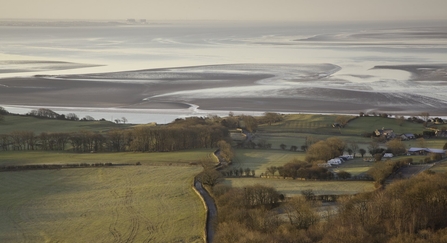
View from Arnside Knott over Morecambe Bay hinterland, Arnside, Cumbria. © Peter Cairns/2020VISION
Saltmarsh
Saltmarshes are intertidal ecosystems, found on sheltered coastlines, such as in estuaries and bays. They may be one of the most efficient habitats on Earth for sequestering and storing carbon in their soils. A hectare of saltmarsh captures over two tonnes of carbon a year.
Up to 100 hectares of saltmarsh are lost every year due to development, agricultural activities, coastal erosion and sea level rise. Saltmarshes are found in the Solway Firth, Morecambe Bay, Ribble Estuary, Mersey Estuary, and the Dee Estuary.
Shellfish
Shellfish take in carbon in the form of calcium carbonate, via shell production, with carbon comprising 11.7% of shell material. Shellfish can form beds that are dense enough to be regarded as biogenic reefs.
Blue mussel reefs are the North West’s most significant shellfish habitat and can be found in the Solway Firth, Morecambe Bay (the mussel beds in Morecambe Bay are quite unique, putting down vast quantities of ‘mussel mud’), Ribble Estuary, and Dee Estuary.
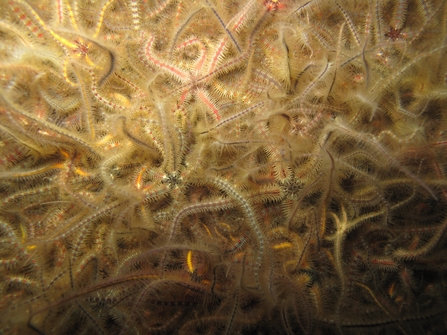
©Polly Whyte-Earth in Focus
Brittle stars
Brittle stars are echinoderms (related to starfish and sea urchins) that have a calcareous skeleton, using calcium carbonate found in seawater. As such, they may play an important (and largely overlooked) role in the marine carbon cycle.
Brittlestars are found in low numbers across rocky shores but they come together in dense aggregations in sandy sediments offshore. They can be found in areas like West of Walney Marine Conservation Zone.
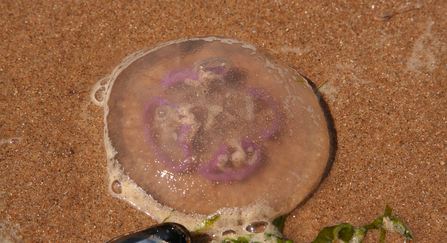
WildNet - Julie Hatcher
Water column
Marine plankton in surface water take up CO2 through photosynthesis. Some of this carbon is then transferred to the deep ocean and is buried in marine sediment. Globally, phytoplankton may be responsible for the transfer of about 10 billion tonnes of carbon from the atmosphere to the deep ocean every year. Other zooplankton, jellyfish, fish and even things like dead whales all hold a significant amount of carbon.
For example, globally, 3.7-6.8 billion tonnes of carbon can be traced back to jellyfish annually. This is the equivalent to the USAs 2018 CO2 emission. A total of 2 billion tonnes of the jelly carbon is thought to make it to the seabed where they breakdown and become incorporated into sediment, so they play an important role in the carbon pump and the transfer of carbon from the water column to the seafloor.
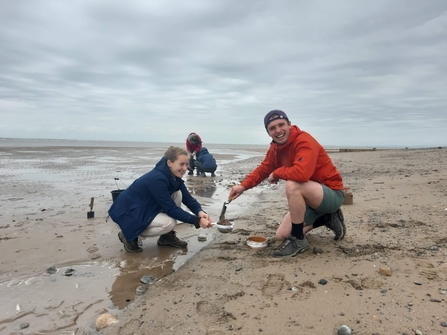
Shore search sediment sampling. Cumbria Wildlife trust
Shelf sediments
Shelf sediments, like that in the Irish Sea, make up 7.6% of the global marine area, but globally sequester as much carbon as tropical forests.
Marine sediments store 2,322 billion tonnes of carbon in the top 1 metre (nearly twice that of terrestrial soils), with 79% of this carbon stored in sediments in deeper waters and almost half of that stock is within the 200-nautical mile Exclusive Economic Zones of countries (Atwood, T. B., Witt, A., Mayorga, J., Hammill, E. & Sala, E. Global patterns in marine sediment carbon stocks. Front. Mar. Sci. 7, 1 (2020)). Intertidal mudflats in the UK cover approximately 2,700 km² and are an important area for carbon storage.
Currently, only a small portion of marine sediment carbon is protected from activities that could lead to the disturbance of ocean sediments and the release of CO2 back into the atmosphere.
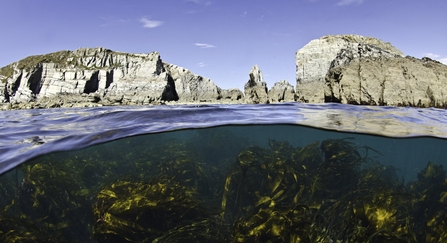
Kelp forest (Laminaria sp.) grows beneath the cliffs of Lundy Island, Devon, England, British Isles. Bristol Channel. - Alexander Mustard/2020VISION
Kelp
UK coastlines are home to more than 650 species of big seaweeds, representing approximately 14% of the world’s known marine seaweeds, and host seven out of 14 European kelp species.
Carbon from subtidal kelp is not stored long-term within kelp beds and instead, the majority (>80%) of kelp production enters the carbon cycle as detritus / DOC (Smale et al., 2013). However, the standing stock of kelp does contain carbon and so it should still be considered as an important habitat.
Help marine life in the Irish Sea
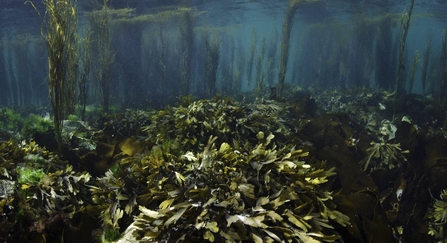
A meadow of seaweeds in the Cairns Of Coll. Island of Coll, Inner Hebrides. Scotland, UK. North East Atlantic Ocean. Photographed in July 2011. @ Alexander Mustard/2020VISION
Did you know?
Our oceans store 20-35% of human-made carbon emissions.
Coastal and marine ecosystems are now known to store up to six times more carbon per unit area than all forests, even undisturbed rainforests.
CO2 is absorbed in surface waters through photosynthesis. Some may be released back into the atmosphere but other carbon is stored in marine sediments where it can stay for centuries and even millennia.
